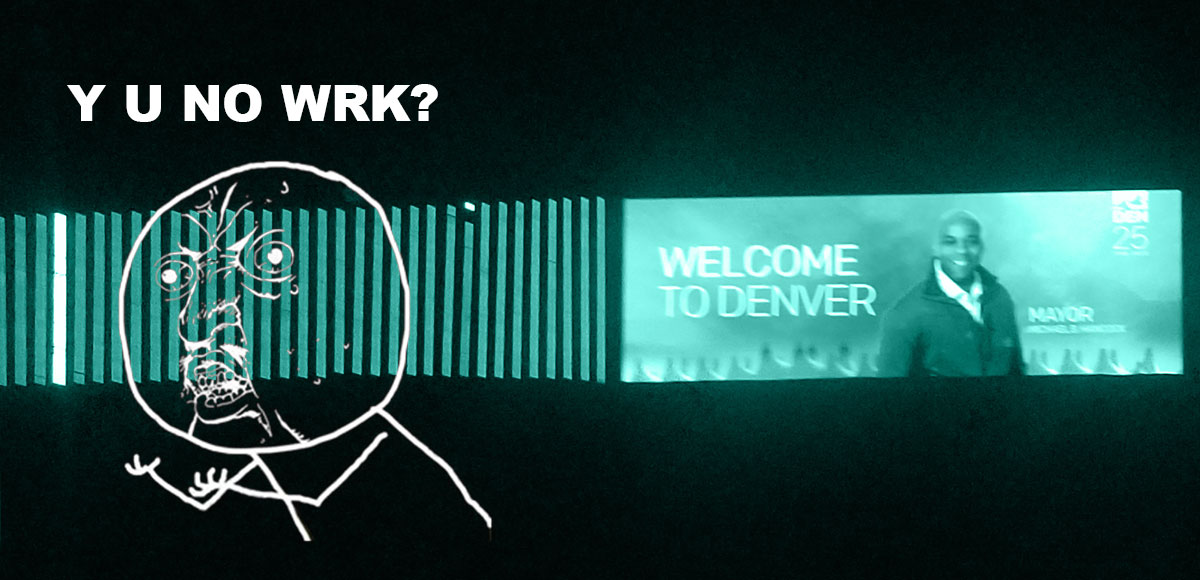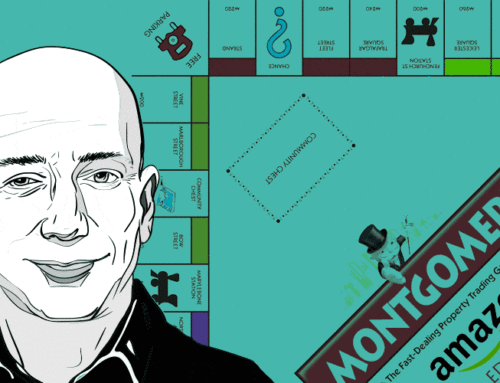Wrong market. Wrong revenue model. Wrong everything.
$14 million dollars and almost 3 years later, all we have is a vomitous broken eyesore in exchange for hiked-up expensive airport parking and food to make up for their crappy investment.
I imagine the pitch went something like this…
Panasonic, “Hey, DIA, we can charge you $7 million dollars to create something weirder and uglier than the blue bronco statue that you have at your airport right now…”
DIA, “But will it stretch long distances, immediately break down, and provide no value whatsoever?”
Panasonic, “It can, but that would be an upgrade and it will cost you more.”
Denver City Council, “Does $14.5 million cover it?”
Panasonic, “Yes.”
You see, DIA figured they would be able to make back this huge cost through advertising. Because apparently they knew nothing about advertising. Or federal regulations related to National Highway Systems. Or how it’s a bad sign (pun intended) when your partner, in this case Panasonic, went from bragging about how awesome the project with DIA is (Old Link – https://info.panasonic.com/Denver-Welcome-Sign.html), to quietly pulling the page from their website and redirecting the old URL to a different page with no mention of the project. Probably because their sign keeps breaking down and nobody is buying advertising.
Let’s do the math together:
-
- Cost of Panasonic Sign: $14,500,000
- Projected Annual Revenue from Ad Sales: $1,200,000 per year
- Projected Payoff on Initial Investment: 12 years
- Total Time Sign Has Been Up: ~2.5 years
- Actual Annual Revenue from Ad Sales: ~$140,000 per year
- Total Ad Sales at the End of 2019: ~$350,000
To be fair to DIA, that means they’re only around $1,000,000 off their forecast per year. So, they should still be able to pay off the sign in 100 years (give or take). But look on the bright side – in the meantime, we have 100 years to look at the glitch piece of crap. Well, that is, when the sign isn’t broken we can look at it .
This all started in 2016 with a dream. That dream was to execute a bad idea.
Where would be the last place in the United States that the community of people who live there would appreciate a 1,000 foot long neon sign? Answer: Denver.
Anyone that lives in Denver (or at least if they’ve lived in Denver more than a few years) will tell you how much they appreciate the outdoors, the conspicuous absence of billboards that would otherwise block the beautiful mountain views, the way all of the buildings blend in to the landscape with their neutral tones and lack of loud signage, and – up until recently – they would say they appreciate the city planning and zoning because it protects real estate value and just simply makes it for a nice place to live and work.
This is why it sucks to watch Denver slip farther and faster into the cesspool of backroom dealing, palm greasing, and politicking that ruins the charm and appeal of Denver. Oh, don’t get me wrong, Denver isn’t immune to this kind of stuff. Just look back to 2011 when IKEA moved in and became a huge eyesore…
A Lesson To Be Learned – It’s Ea$y To $crew Over Denver’$ Citizen$
In 2011, IKEA came to Denver… I imagine the conversation went something like this…
IKEA, “We can you to get people to stop talking about the hideous blue bronco at DIA.”
Centennial Mayor Cathy Noon, “I’m already $old.”
IKEA, “But it will require you to allow us to have an unescapable blue and yellow eyesore of a building that sticks out like a sore thumb. And we want a sign 100 feet tall.”
Centennial Mayor Cathy Noon, “What about ‘I’m already $old’ do you not get?“
SIDE NOTE: Everybody said IKEA’s store design and sign run should be in line with Denver aesthetic and code. Specifically, signs in Centennial are not allowed be higher than 32 feet. To which IKEA said, “Gå jävla själv.” And built a 100-foot tall sign.
How did that 100-foot sign special allowance work out? Oh, glad you asked, IKEA’s sign shut down the I-25 light rail for 2 hours stranding passengers, stopping highway traffic from I-224 to Lincoln, and generally wreaking havoc on people’s lives.
The Only Hero In This Story
His name is Rafael Espinoza. When this crap show came to town and they peddled this scheme to Denver, Rafael was the only councilperson to disagree with this horrible idea. He said it plainly, he said it clear, “We just don’t need it.”
If only there were more Rafael Espinoza’s in this world. But it seems a futile endeavor, even for the Rafael’s of this world, with the headwinds of Denver Government being so strong.


